|
REVIEW ROUNDUP: DEUXIÉME SÉCTION
Stu's Super-Awesome DS Review Bonanza (Part 2)
The DS is well into its second phase of blockbuster releases now, with such first-division Nintendo big hitters as Pokémon and Donkey Kong entering the fray to try to deliver yet more haymakers to Sony's unfortunate and increasingly abandoned PSP as it lies slumped and gasping against the ropes desperately praying for a Gran Turismo-shaped white knight to make its long-delayed arrival and offer at least a hope of salvation. So let's fire up that flashcart again, go for a long train journey and take an extended look at another bunch of titles - big names and not so big, new and not so new - and see what's what. And just to stick with the whole "duality" conceit, let's do 'em in themed pairs! (Steady. - Ed)
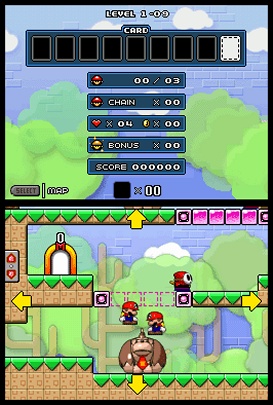 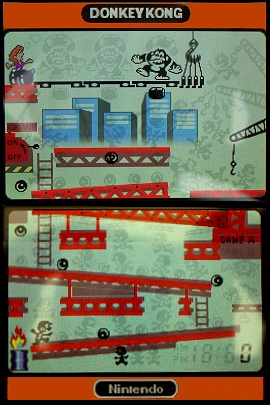
It's official: progress is bad.
MARIO Vs DONKEY KONG 2: MARCH OF THE MINIS (Nintendo)
Your reviewer was particularly looking forward to this one, with the two previous Donkey Kong platformers on GB and GBA having been among the very finest games of both their genre and their respective generations. So it's something of a bummer that MVDK2 fulfils neither of those criteria. This is a radical departure from the two earlier titles - it's not really a platform game at all (it's more of a puzzler, in a very similar vein to old Amiga games like Lemmings, Troddlers and Krusty's Fun House), and it's also not very good.
Rather than playing Mario himself, each level of MVDK2 gives you control of a bunch of clockwork-toy facsimiles of the little fella (usually two, three or four). You move them around not with the d-pad but with the stylus - nudge a mini-Mario in one direction and it'll keep moving that way until you tap it to make it stop, and flicking it upwards will make it do a little jump. Your job is to guide your team to the exit safely, collecting coins, letter cards and power-ups, and flicking switches to open doors, move lifts and redirect conveyor belts to guide your little guys safely around the various obstacles and enemies on each level. The main problem is that the levels are so big you can rarely see more than one Mario at a time, so you have to constantly scroll around with the d-pad while moving the mini-toys with the stylus (which doesn't quite have the precision to respond as quickly and accurately as you'd hope), trying to remember or guess where the others are and what they might be up to.
Perhaps in compensation for the awkward design and control, Nintendo have made the game dismayingly easy, with your reviewer having so far cleared more than 50 of the 100 levels without ever having to play one more than twice (and usually only then as a result of a stylus slip rather than any inherent difficulty or puzzle). The only challenge is if you play to get gold stars on each level rather than merely beat it and move on (which will usually mean doing it in a single continuous perfect sweep), but MVDK2 isn't anywhere near interesting or rewarding enough to justify the repetitive trial and error required to perform such a feat. Fiddly and vague and loose where the previous games were snappy and clean and sharp, dull and gruelling and obvious where they were fun, inventive and challenging, this is meant for kids, but (as with Super Princess Peach) they deserve better. If it wasn't by Nintendo and didn't have Mario in it, nobody would give it a second glance, and they'd be right. 4/10
------------------------------------------------------------------------------------------
GAME & WATCH COLLECTION (Nintendo)
Meanwhile, another new release featuring the same two classic protagonists takes its gameplay in the opposite direction, right back to the roots of platform gaming, using the features of the DS in a very different way, and is much more fun for it. Game & Watch Collection gathers together three of Nintendo's scores of old LCD handheld games of the 1980s - specifically Greenhouse, Oil Panic and our old friend Donkey Kong - and uses the DS to elegantly replicate their dual-screen construction.
The games are all straight, faithful copies of the originals (there are no updated versions such as the remakes found on the GB and GBA's "Game & Watch Gallery" collections), but were so tightly designed in order to provide lasting fun on the highly limited LCD hardware that all three are much more fun than MVDK2, with Donkey Kong's constantly-shifting tactics and difficulty making it the best of the bunch. The cart is only currently available as a reward for members of the "Club Nintendo" loyalty scheme in Japan, so you'll have to snag one on eBay if you want to play it, but playing these primitive games to beat your high scores is simply a lot more enjoyable than tackling their bells-and-whistles descendant. 7/10
------------------------------------------------------------------------------------------
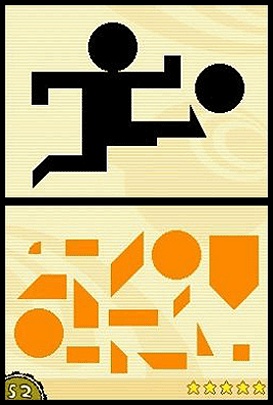 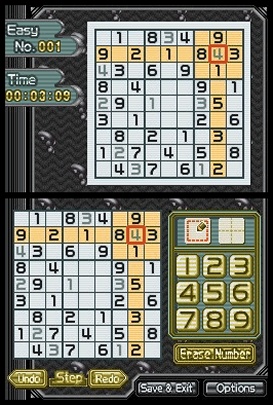
In BBA, you have to make the top picture out of the shapes below. In about five seconds.
BIG BRAIN ACADEMY (Nintendo)
The second of the DS's mental-exercise titles is much more of an actual game than Brain Training. Whereas Dr Kawashima doesn't offer much in the way of incentives once you've hit the magical "brain age" of 20 - which you can do by luck on your first try - Big Brain Academy is a more straightforward high-score game where playing better will increase the notional weight of your grey matter, so there's always a target to aim for. The 15 mini-games are all unlocked from the start, and none of them involve shouting at your DS in public (which also neatly dodges the voice-recognition problems that plague a couple of the good doctor's games), and there's more variation too - most of Brain Training boils down to counting stuff, whereas here you have to recognise and manipulate shapes, memorise things and perform both arithmetical and visual calculations. While it lacks the faux-scientific gravitas of the other game, BBA has at least as much character as the fun-loving doc, being presented by what appears to be a condom with arms and a predilection for saying things like "w00t! I am teh l33t haxx0r!". It doesn't use the touch screen as innovatively as its competitor, but there's more lasting fun to be found here. 7/10
------------------------------------------------------------------------------------------
SUDOKU GRIDMASTER (Hudson Soft)
These two go together, obviously, because the other big selling point of Dr Kawashima's Brain Training is its collection of Sudoku puzzles, so if you plump for Big Brain Academy you'll need to buy your Sudoku game separately. Of the two Sudoku games released in the West, Gridmaster is the slickest by a long way, with a simple and intuitive interface (you wouldn't believe what a mess Sudoku Mania manages to make of it) constructed around a whopping catalogue of 500 puzzles, arranged into four difficulty groups (the numbers weighted towards the harder groups). In a nice bit of attention to detail, you can either tap numbers to fill in the boxes, or write them on the touchscreen. You can also earn the right to tackle "rank tests", and the game keeps star ratings and record times for individual puzzles, so this is all the Sudoku you'll ever need. (If, indeed, you need any Sudoku at all.) 6/10
------------------------------------------------------------------------------------------
 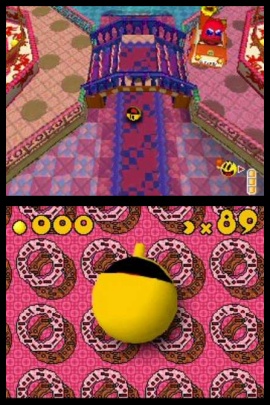
It'll save us all a lot of time if you make up your own "balls" joke here.
SUPER MONKEY BALL - TOUCH & ROLL (Sega)
SMB ought to be the perfect game for the innovative control of the DS, the touchscreen allowing for immediate and precise manoeuvring of the spheroid-encased simians. And it almost is, except for a slightly too-low sensitivity setting which leaves you struggling to slow your monkey sufficiently as it hurtles down a steep slope towards certain death, or get it going fast enough to make a big jump - in fact, it turns out to be substantially easier to play the game with the d-pad, which is kinda missing the point. Monkey Ball is all about precise analogue control (as anyone who ever played the N-Gage version will sorrowfully tell you), and turning it digital sucks an awful lot of the fun out of it. In the end, it just ain't right. 5/10
------------------------------------------------------------------------------------------
PAC'N'ROLL (Namco)
Namco, on the other hand, have given Sega a bit of a lesson in how to build a world around a control method. Pac'n'Roll uses the DS's input in exactly the same way as Super Monkey Ball, but the levels are far more "enclosed", allowing the player to whizz around them with speed and fluidity but still be able to recover from mistakes. Design-wise it's a little more akin to something like Pandemonium than the Marble Madness-derived SMB, with a pretty limited amount of freedom, but the linearity is well-disguised and unobtrusive, and helps to ensure the game keeps moving along at a lively pace. It gets slightly over-complicated later on as more Pac-moves are introduced, and there are a few minor camera issues, but if you're looking for a fun ball-rolling game for your DS you'll almost certainly find yourself more entertained by this one than its more celebrated counterpart. 6/10
------------------------------------------------------------------------------------------
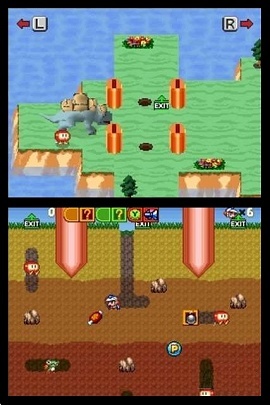 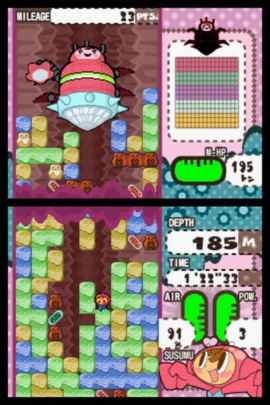
Perhaps one day Namco will manage to combine all three games into one, somehow.
------------------------------------------------------------------------------------------
MR DRILLER: DRILL SPIRITS (Namco)
The most celebrated Namco character of recent years, of course, is that lovable little subterranean cheeky chappy Mr Driller. Star of a surprisingly large number of games, all of them essentially the same, the wee fella's up to his usual tricks here, digging ever-downwards through pits full of coloured blocks, all located in inexplicable vacuums below city streets. You get a lot of Driller for your money here - as well as the standard arcade game, there's "Pressure Driller" (pictured above, where you have to dig out fireballs to shoot at the giant pursuing enemy drillship), "Time Attack" (get to the bottom of short preset levels against a very tight time limit) and "Dristone Driller" (not present in the US release), a more strategic game in which you only use up your air supply when you actually move, and can collect various bonus items to help you out of particularly tricky spots.
Drill Spirits is a respectable, middling sort of Driller game. It lacks the sophistication of Strange Bacteria (the Japan-only sequel on GBA), the fun of the "Drindy Adventure" game in Gamecube incarnation Drill Land, and the addictive genius of "Endless Hard" more on the GBA's Mr Driller 2, but on the upside the extra screen comes in handy for seeing stuff that's about to fall on your head. Hours of solid, but rather unimaginative, entertainment for existing Driller fans, and a good sound introduction to a classic for everyone else. 7/10
------------------------------------------------------------------------------------------
DIG DUG: DIGGING STRIKE (Namco)
The latest in the 25-year-old Dig Dug series, of course, belongs alongside Mr Driller because according to Namco plot continuity, Dig Dug (or "Taizo Hori", as apparently the character is actually called) is Mr Driller's dad. This provides the excuse for a fantastic storyline in which Taizo gets fed up with his offspring hogging all the glory and sets out, to everyone's consternation, to solve a subterranean crisis himself. By an astoundingly lucky chance, this crisis takes the form of an almost exact hybrid of Dig Dug and Dig Dug 2.
The first two Dig Dugs were radically different games, and playing them simultaneously (the original on the bottom screen, the sequel on the top) makes for a confusing experience, where you're never quite sure which of the two you should be focusing on. (Perhaps it's trying to simulate the addled mental condition of senile old Grandpa Dug.) Is it more important to clear out the monsters on the bottom screen, or should you largely ignore them in order to concentrate on sinking chunks of the island on the top screen? Throwing in several little power-up sub-games based on other Namco classics like Rally-X and Xevious doesn't simplify things any either, and in the end you find yourself admiring the inventiveness of combining the two games into one, but not actually wanting to play it very much. 5/10
------------------------------------------------------------------------------------------
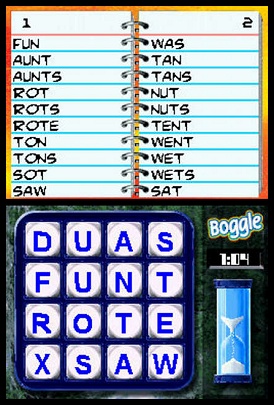 
Man, wouldn't it be great if "FUNT" was a real word?
4 GAMES IN 1: MONOPOLY, BOGGLE, YAHTZEE, BATTLESHIP (Atari)
It's long been a source of mystery to your correspondent that (a) a game as fundamentally dull as Battleship has been ported to so many home formats in the first place, and (b) none of them have ever learned the lessons of one of the earliest ports. The 1988 Spectrum budget game by Encore made two simple, but genius, changes to the basic Battleship design, most crucially making your number of shots depend on how many ships you still had afloat.
This one alteration (combined with making the different ships occupy irregular Tetris-style shapes on the grid rather than straight lines) approximately doubles the amount of strategy in the game - because you now actually get rewarded for sinking enemy ships, rather than effectively punished by having fewer targets to aim at - and the multiple shots (you start off with a whopping 24 per turn, rather than the feeble one of the traditional game, losing four for each ship sunk) make the whole thing feel much faster and more exciting. It's still Battleship, of course, but it's about as much fun as you could possibly make what's essentially a completely random guessing game, so nobody has any excuse for releasing a crushingly tedious port like the ten-minute job Atari have dumped on this compilation. With a single shot at a time, you'll die of boredom as you inevitably hunt down the enemy's smallest ship last of all, and if you make it to the end of even one game (at which point, if you lose, the useless piece of crap commits the WORST CRIME POSSIBLE IN A COMPUTER BATTLESHIP GAME, namely not showing you where the remaining enemy ships you've just spent 10 fruitless minutes hunting for had been hiding), you deserve some kind of a medal for special naval valour. Worse things happen at sea? Not worse than this, they don't.
As for the rest of the compilation, Monopoly is pretty much exactly what you'd expect (ie slow and overloaded with superfluous animations), while Boggle - which ought to be perfectly suited to the DS touch screen - is hampered by a terrible vocabulary, sometimes failing to recognise the simplest of words. Yahtzee is the best thing here by a way, almost single-handedly rescuing the cart by the simple expedient of saving your high scores, giving you something to aim at the next time you play. Even then Atari have tried to ruin it, with a belief-defyingly inept interface (something common to all four games, featuring inexplicable cack-handed stupidities like having to sign your name by cycling through letters instead of just tapping on them) which somehow contrives to have you require both the stylus and the d-pad in order to simulate a pencil and a bit of paper, but this reviewer found it curiously addictive. With so many wonderful DS games out there you'd need to be out of your mind to put this at the top of your shopping list, but if you can pick it up in a bargain bin somewhere for £10, you'll just about get your money's worth from Yahtzee and Boggle. 5/10
------------------------------------------------------------------------------------------
42 ALL-TIME CLASSICS (Nintendo)
There's a much more detailed breakdown of this alternative collection of traditional parlour games on the WoS forum thread, so we'll keep it short here. 42 All Time Classics does exactly what it says on the tin, bringing a wide variety of board, card, pub and party games together on a single cart with both CPU opponents and some really well thought-out Wi-Fi multiplay. There are various modes for longer or shorter challenges, things to unlock, and extensive rules supplied in case you've never encountered games like Shogi or Hanafuda before. Whether you're trying to master throwing darts with the stylus, battling the fiendish Connect Five or scratching your head over what the hell's going on in Contract Bridge, there are hours and hours and hours of solo and multiplayer entertainment to be found here, and going out at two-thirds of the price of most DS titles, it deserves to be a colossal success.
While there are a few minor flaws (the CPU opposition is very weak in some of the games, some of the games don't save high scores, and it would have been nice to be able to play two-player games on a single DS), it'd be absurd and churlish to quibble with the value offered by this fantastic little package. That's how you do it, Atari, you muppets. 9/10
------------------------------------------------------------------------------------------
END OF PART 2
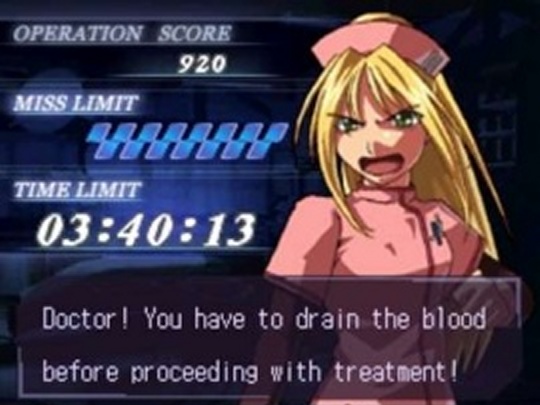
Join us next time, when we may or may not get round to following this sage advice.
|

